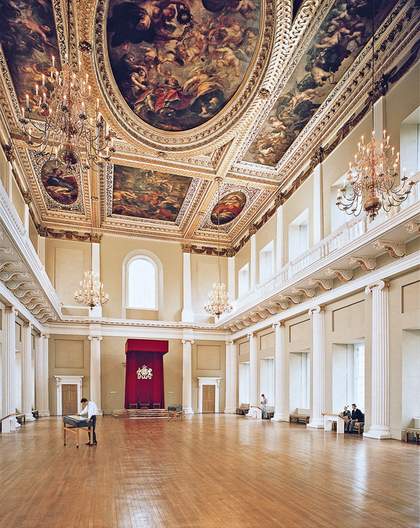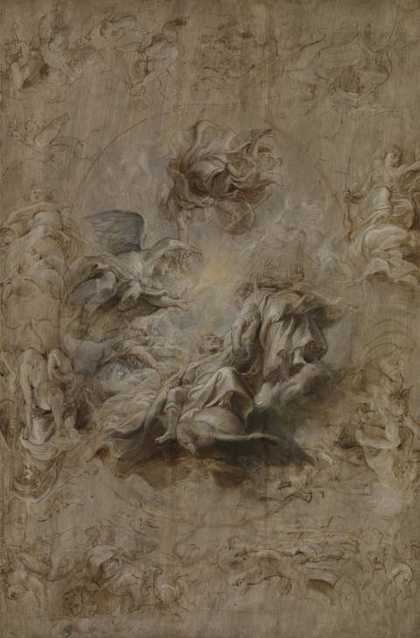It’s no coincidence that the bus between Tate Britain and the Banqueting House in Whitehall is the Number 88. Known by its bingo call, the “Two Fat Ladies” carries art lovers in search of the pneumatic female nudes of Peter Paul Rubens from one venue to the other. At Tate Britain you can see his preparatory oil sketch for The Apotheosis of James I, and at the Banqueting House you can see the finished work in the form of his spectacular painted ceiling. Both speak volumes about art and power at the court of the Stuart monarchs. This autumn the sketch forms the heart of a timely display and celebration of Rubens’s links with Britain, triggered by Tate’s acquisition of the work three years ago. For one brief but joyous morning in 2008, during the fundraising campaign for its purchase, it was displayed in the Banqueting House itself.
Inigo Jones’s building is one of the last remnants of the lost palace of Whitehall. Today it’s looked after by Historic Royal Palaces, the independent charity responsible for the unoccupied royal palaces of London. Open to visitors by day, the Banqueting House really comes into its own at night, when it’s frequently still used (as originally intended) as a venue for some of the grandest parties in the capital. Office workers and tourists rushing down Whitehall are used to seeing classical buildings, and don’t realise that this was one of the first in Britain. Nor do they notice that inside it Rubens helped the Stuart kings to make a daring – and ultimately dangerous – declaration of their divine authority.
Contrary to what you might expect, the nine vast canvases of the ceiling weren’t actually painted during the artist’s trip to London. But many of the people he met and the works he did complete here will be featured in the new exhibition.

Main hall of the Banqueting House, London
© Historic Royal Palaces
It was a visit that was warmly anticipated, because Rubens was more than just a painter. In an age when it was much harder to obtain an image of someone, a skilful portrait artist was highly valued. Pictures of the players involved, and the international bonding that could develop out of a shared interest in art, were absolutely essential to the diplomacy of Europe. That’s why sovereigns and rulers were happy to spend time with him: he was a courtier as much as a craftsman. Karen Hearn, Tate’s curator of sixteenth and seventeenth-century British art and the curator of the Rubens and Britain show, thinks that ‘Rubens would have been such an interesting person to meet: brilliant linguist, very well read, multi-tasker, clearly good company, very much a diplomat’. Indeed, a contemporary noted that ‘he appeared everywhere, not like a painter but a great cavalier with a very stately train of servants, horses, coaches, liveries and so forth’.
Perhaps the trigger for his secondary career as a proto-ambassador was the death, in 1626, of his first wife. It seems he busied himself with more ambitious art commissions to ease his grief. He also wanted the various European powers quarrelling over his homeland, the part of the Netherlands then under Spanish rule, to get along better. So in 1628 he left his home city of Antwerp to visit the court of Spain at the invitation of King Philip IV. In Madrid he became close to the monarch and familiar with his almost miraculous art treasures. Philip then dispatched him to London, with the mission of facilitating a peace treaty between Spain and Britain.
Rubens arrived in 1629. How would the court of Charles I have struck this well-travelled connoisseur and friend of kings? He might plausibly have seen Britain as a remote, rainy, artistically backward country, but seems instead to have been favourably impressed. Maybe Rubens the diplomat was just being polite, but in truth Britain’s court was now headed by a man personally obsessed with art, culture, beauty and rarities.
For me, the image that best captures the atmosphere of the Stuart court is Gerrit van Honthorst’s allegorical picture Apollo and Diana 1628. Displayed at Hampton Court, it shows the figure of Mercury leading the Liberal Arts over the Alps and being welcomed by Apollo and Diana into a northern realm. The message becomes clear when you work out that Charles’s favourite and Rubens’s acquaintance, the art-loving Duke of Buckingham, is wearing the helmet as Mercury, and that he’s leading the Liberal Arts into the presence of the king and his wife Henrietta Maria, themselves taking the parts of Apollo and Diana.
The three appear in mythical costume – as indeed they sometimes did in real life. Occasionally, they performed personally in the court masques and parties staged in the Banqueting House. In Honthorst’s picture, Charles, wearing an off-the-shoulder red toga, is seated with his wife upon what appears to be a mechanical floating cloud, one of the ‘special effects’ employed in these terrifically extravagant court entertainments. Honthorst shows us the British court as Rubens saw it: in vivid colour and dramatic shadow, full of a love of learning and diligently dedicated to the arts.
Other court characters to be illustrated by Rubens’s hand in the new exhibition include the cultivated and humorous Sir Theodore de Mayerne, Charles’s doctor, and the great collector Thomas Howard, Earl of Arundel. Rubens found them all most congenial. In Britain, as he wrote, he liked the countryside, the rich and happy people and, above all, ‘the incredible quantity of excellent pictures, statues, and ancient inscriptions which are to be found in this Court’.
All these strands would come together in the completion of the Banqueting House. Charles’s father James I had commissioned Inigo Jones, Britain’s first architect to understand classicism, to design it as an entirely new sort of building, inspired by those of the ancients. But James died before the work was finished.
The question of the interior decoration was delegated to a group of art-loving courtiers. ‘It’s possible that there was a kind of committee of taste,’ says Karen Hearn, ‘a group who were involved in the design, putting forward ideas for the ceiling.’ The committee drew up lists of ideas for the subject matter (documents also to be displayed in Tate’s exhibition) and seems to have asked for Rubens’s help in the execution. Such was his talent for suave self-promotion that scholars aren’t sure if the letter quoted here is a pitch or a thank-you for the job: ‘My talent is such that no undertaking, however vast in size or diversified in subject, has ever surpassed my courage.’
He was to complete three main panels, representing The Union of the Crowns of England and Scotland near the entrance, The Peaceful Reign of James I at the far end over the throne and, in the middle, The Apotheosis of James I. The Tate oil sketch looks like a sample panel prepared for Charles’s personal approval. If that’s so, then it too belongs among the select group of works actually completed by Rubens during his stay.
Many other sketches exist for different parts of the ceiling, but Tate’s is the most important of them all. It is in Rubens’s own hand, while the ceiling would be completed by a team of assistants. The other versions show interesting variations on the foreshortening of James’s figure. Clearly Rubens was playing with proportion, something vital in an image intended to be seen from below.
He completed the actual ceiling canvases on his return to Antwerp, and shipped them over to England for installation. The finished ceiling spoke triumphantly about the union of England and Scotland achieved in the person of Charles’s father, his peace-loving and virtuous qualities as a ruler and the presumed apotheosis of James I after his death. The purpose of the room was to overwhelm visitors with the visual power and magnificence of the assembled British court. Here, Charles would welcome ambassadors and heads of state, glancing upwards at his deified father as he did so, and imagining himself the son of a god. Rubens could not have given him a more flattering image of a safe, secure and pacific dynasty.
Or so it seemed. Back in Antwerp, the artist went on working for the Spanish royal family, found happiness with a sixteen-year-old second wife, and finally died in 1640. Ironically, though, the powerful weapon that he’d added to Charles’s visual arsenal didn’t ultimately do the king any good at all. The idea of a ceiling glorifying James seemed appropriate at the time, but after 1640 it set teeth on edge. Charles may have thought he was the son of a god, but unfortunately he acted rather too much like one – and eventually annoyed his people to the point of rebellion and civil war. It’s no surprise that after his defeat in battle, his capture and imprisonment, the most chagrined of his erstwhile subjects cut off his head right outside the Banqueting House. It had become a symbol of all that was most impressive but most offensively arrogant about the Stuarts.
In Britain, then, Rubens did his job almost too well. He turned the Stuarts into something more than human, and so contributed to their downfall. As an artist, it was a magnificent achievement. As a statesman, it was rather misjudged.

